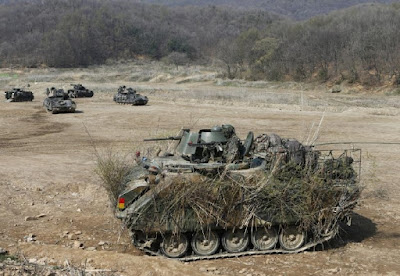The Korean Demilitarized Zone (DMZ) is the buffer zone between North and South Korea, running across the peninsula roughly following the 38th parallel. It was created by agreement between North Korea, China and the United Nations in 1953. The DMZ is 250 kilometres (160 miles) long, and about 4 kilometres (2.5 miles) wide.
Within the DMZ is a meeting-point between the two nations in the small Joint Security Area (JSA) near the western end of the zone, where negotiations take place. There have been various incidents in and around the DMZ, with military and civilian casualties on both sides. Several tunnels are claimed to have been built as an invasion route for the North Koreans.
Location
The Korean Demilitarized Zone is a strip of land running across the Korean Peninsula. It was established at the end of the Korean War to serve as a buffer zone between North and South Korea. The DMZ is a de facto border barrier that divides the Korean Peninsula roughly in half. The DMZ roughly flows the 38th parallel north on an angle, with the west end of the DMZ lying south of the parallel and the east end lying north of it. It was created as part of the Korean Armistice Agreement between North Korea, the People's Republic of China, and the United Nations Command forces in 1953. The DMZ is 250 kilometres (160 miles) long, approximately 4 km (2.5 mi) wide and, despite its name, is the most heavily militarized border in the world. The Northern Limit Line, or NLL, is the disputed maritime demarcation line between North and South Korea in the Yellow Sea, not agreed in the armistice. The coastline and islands on both sides of the NLL are also heavily militarized.
History
The 38th parallel north—which divides the Korean Peninsula roughly in half—was the original boundary between the United States and Soviet Union's brief administration areas of Korea at the end of World War II. Upon the creation of the Democratic People's Republic of Korea (DPRK, informally North Korea) and the Republic of Korea (ROK, informally South Korea) in 1948, it became a de facto international border and one of the most tense fronts in the Cold War.
Both the North and the South remained dependent on their sponsor states from 1948 to the outbreak of the Korean War. That conflict, which claimed over three million lives and divided the Korean Peninsula along ideological lines, commenced on June 25, 1950, with a full-front DPRK invasion across the 38th parallel, and ended in 1953 after international intervention pushed the front of the war back to near the 38th parallel.
Joint Security Area
Inside the DMZ, near the western coast of the peninsula, Panmunjom is the home of the Joint Security Area (JSA). Originally, it was the only connection between North and South Korea[9] but that changed in 2007 when a Korail train crossed the DMZ to the North on the new Donghae Bukbu Line built on the east coast of Korea.
There are several buildings on both the north and the south side of the Military Demarcation Line (MDL), and there have been some built on top of it. The JSA is the location where all negotiations since 1953 have been held, including statements of Korean solidarity, which have generally amounted to little except a slight decline of tensions. The MDL goes through the conference rooms and down the middle of the conference tables where the North Koreans and the United Nations Command (primarily South Koreans and Americans) meet face to face.

























0 Comments